This post may contain affiliate links. If you use these links to buy something we may earn a commission. Thanks.
The best ground cover companions under fruit trees are multi-functional, good-looking, and perhaps edible. With the right plants, you can turn any fruit tree into a food forest island with a thriving ecosystem.
The best fruit tree companion plants suppress weeds, repel pests, attract pollinators and predators, and protect and improve the soil. A diverse arrangement of companions that serve all of these functions together is referred to as a guild. A thriving guild can be made of 3-8 or more beneficial plants.
This article shows you some of the best options for each functioning companion plant category.
Having a guild (rather than a plain mulched tree) can add several benefits that mulch doesn’t provide.
A community of plants offers their best traits to each other and weak points become harder for pests and diseases to find in the first place.
Plants that balance pests with predators include nectar-rich pollinator plants, scent-confusers, and aromatic, physical, or fodder repellents.
Plants that improve the soil under your fruit trees include; nitrogen-fixers, weed suppressors, mulchers, and dynamic accumulators.
A team of plants that fulfill these duties will keep a tree protected, nourished, and healthy long-term.
Building soil health prevents disease, and building community prevents attack.
Related: 12 Low-Growing (Low Maintenance) Edible Ground Covers
Disclaimer: Food Forest Living or its authors are not responsible for what you choose to consume. Do your own research before consuming anything “edible” or “medicinal.” Before planting any of these options check with your local invasive plant council or regional extension office for guidance on plants that may be invasive in your area.
The best nitrogen fixers for fruit tree guilds
The best ground cover nitrogen fixers include moss phlox, blue false indigo, clover, lupines, hog peanut, ground nut, and lentils.
Nitrogen-fixing plants aren’t limited to ground covers and perennials—longer-lived shrubs and trees also have nitrogen-fixing options. If you have the space, I recommend making a guild or three with a nitrogen-fixing tree or shrub as the center with other functional companions around.
In this article, we’re going to find a nitrogen-fixation companion to your non-N-fixing tree.
To grow under your tree, partial shade may need to be tolerated, at least when your tree matures.
If you’ve planted a brand new 2 or 3-year-old tree then you can get away with growing sun-loving nitrogen fixers until your canopy fills in after 3 years.
After 3 years, the companion plants at the base of your tree would need to tolerate partial shade.
| Edible | N-Fixer | Pollin. | S.C. | Repel. | W.S. | Mulch | D.A | |
| Blue false indigo | Y | Y | Y | |||||
| Dutch clover | Y | Y | Y | Y | Y | |||
| Lupine | Y | Y | Y | Y | ||||
| Hog peanut | Y | Y | Y | |||||
| Ground nut | Y | Y | Y | |||||
| Lentils | Y | Y | ||||||
| Comfrey | Y | Y | Y | Y |
Blue false indigo
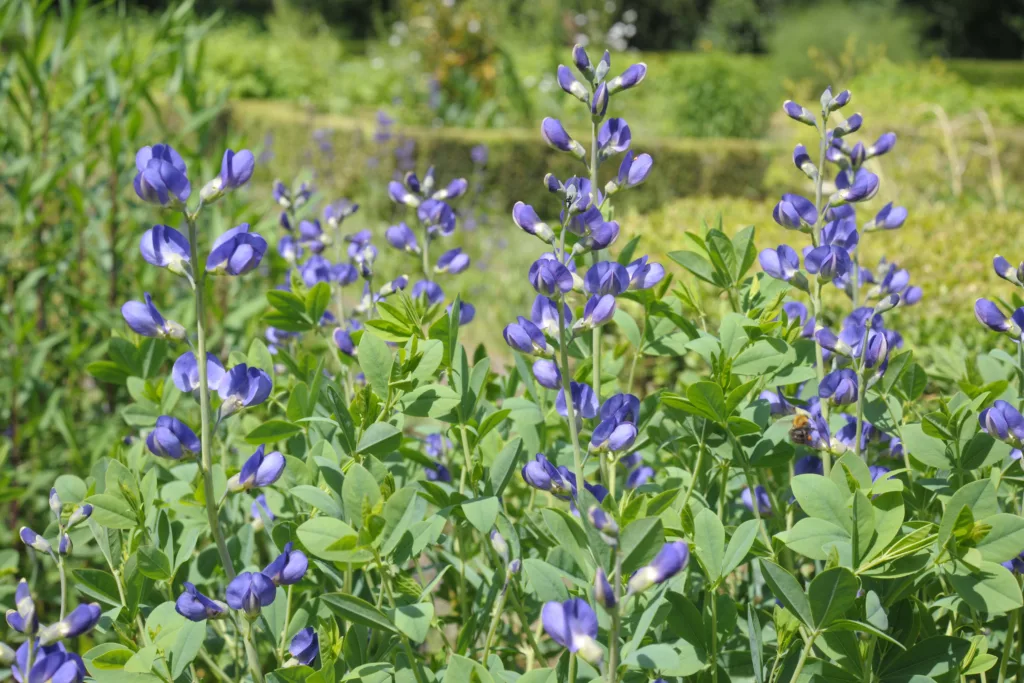
Native to North America, this nitrogen fixer has gorgeous blue flowers from July to August.
Full sun is preferred and light shade works too. Partial shade isn’t ideal as it likes hot dry conditions.
Deer and rabbits don’t find blue false indigo particularly palatable, and it attracts birds and plenty of pollinators making the edge of the tree guild an ideal placement.
Order deer-resistant shrubs, herbaceous perennials, bulbs, roses, or ground covers.
Dutch clover
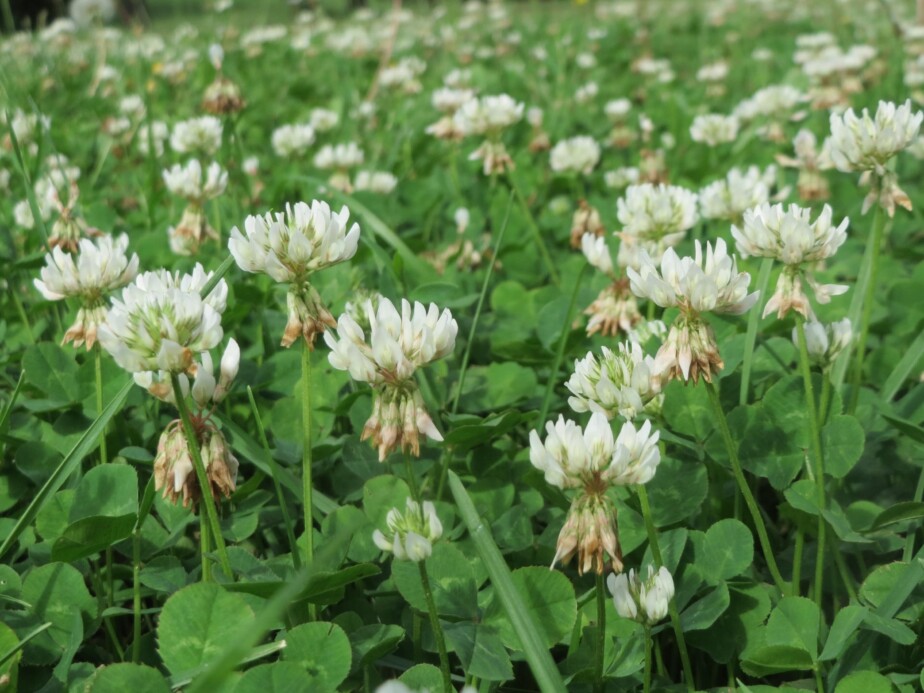
Although clover is popular in many places, the native range is Europe, North Africa, and Asia.
Clover is a low-growing legume that can be seeded densely to crowd out weeds. A popular choice of ground cover as it is easy to seed, low-maintenance to grow, pollinator-friendly, edible, and gorgeous to look at.
Clover is often used as a grass replacement for its multi-functional purpose and needs for less costly upkeep.
Lupine
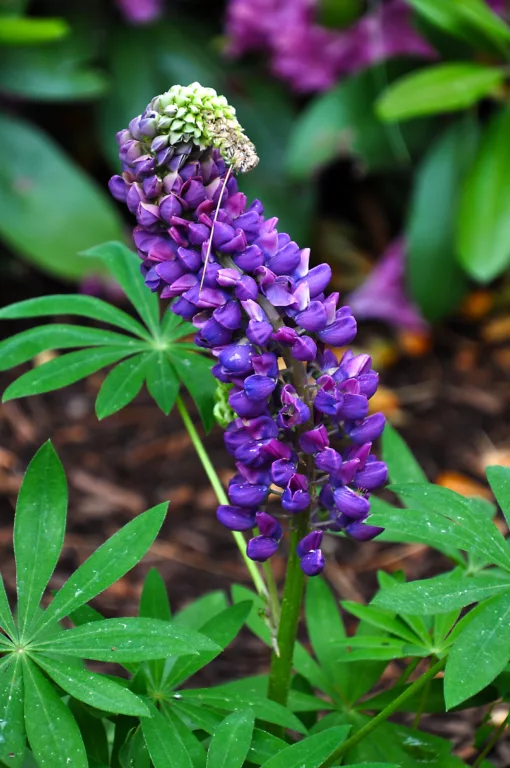
This article was originally published on foodforestliving.com. If it is now published on any other site, it was done without permission from the copyright owner.
The native range of this gorgeous legume is North America.
Some regard lupine as a dynamic accumulator as is most often used as a medium-life nitrogen fixer.
Lupines live for 5-6 years which is a great time frame for planting among the first plants of your food forest for nitrogen fixation. The accumulation of nitrogen is shared after the plant has terminated either manually or upon its natural lifecycle.
Be sure to propagate your lupines every year to keep them going. Eventually, you’ll have a gorgeous supply of nitrogen for the whole garden.
They attract butterflies, other pollinators, and birds. Full sun is ideal.
Hog peanut (Amphicarpaea bracteata)
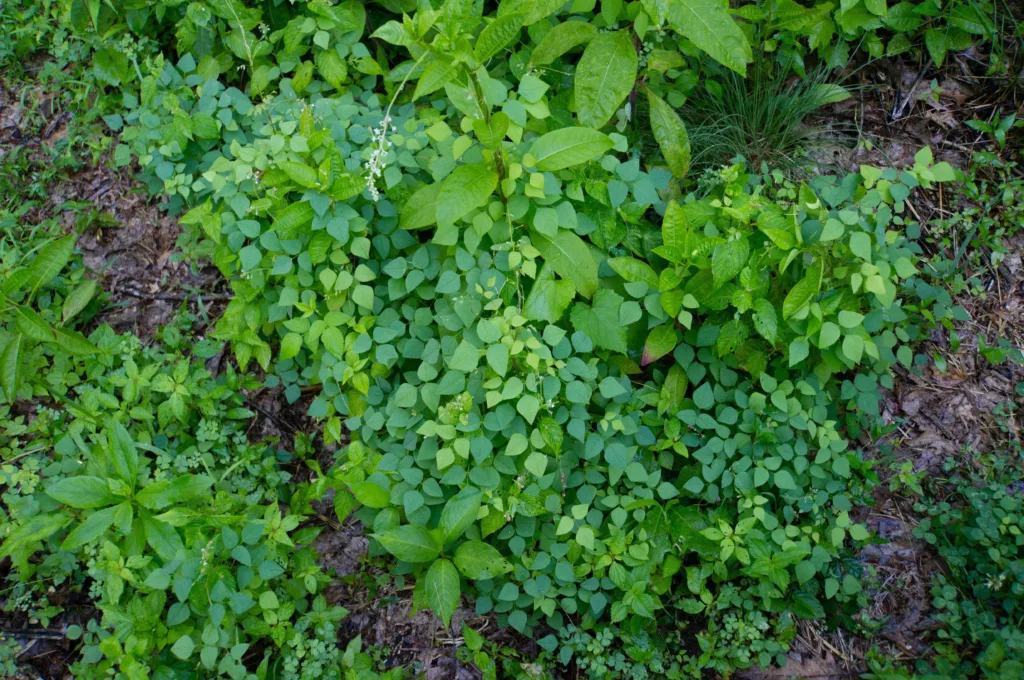
Native to North America; hog peanuts are all over our shady forested areas growing naturally.
The food source is somewhat insignificant but a handful can be achieved in about 5 minutes of concentrated foraging.
Two parts are edible. The underground pods have larger seeds and the above-ground pods have small seeds. Both are nutritious and tedious.
Hog peanuts need shade. They can grow in full deep shade or partial shade and are an excellent weed suppressor with cute leaves. If the plant gets out of hand simply chop and drop.
Ground nut (Apios Americana)
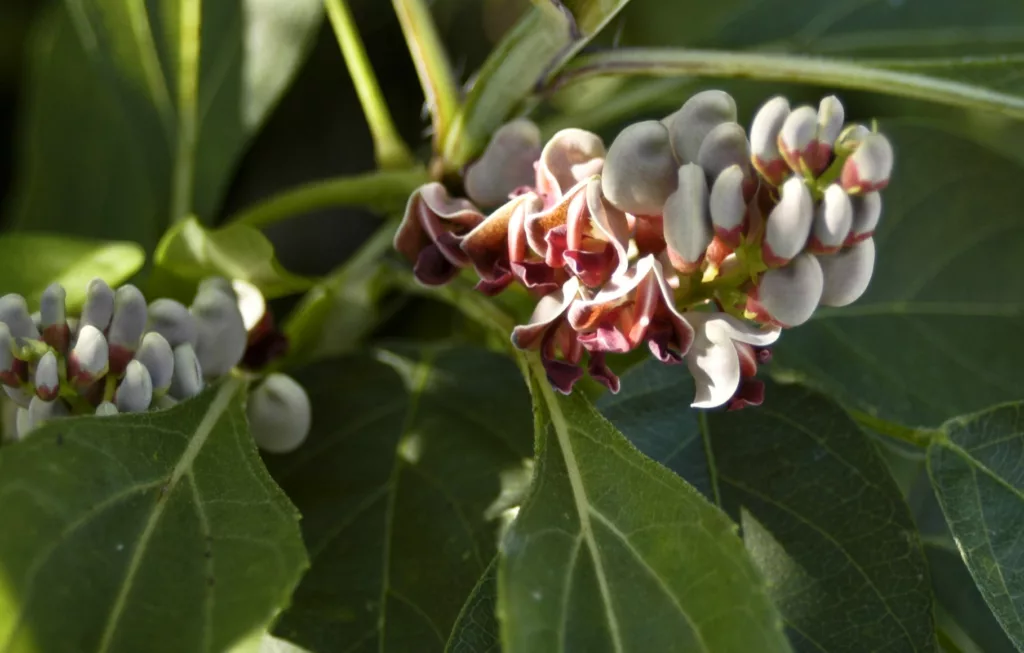
Native to North America, the ground nut has edible tubers and seeds.
We have yet to obtain ground nuts for our food forest and have them on our list because apparently the tubers taste great, and provide calories, and the seeds are like beans! Plus, not only are the flowers gorgeous, but they have also been considered a scent confuser due to their peculiar odor.
A multi-functional vining companion with a preference for full or partial sun can be placed on the edge of a tree guild or with a mature, and well-pruned open vase tree that lets sunlight in on the vine.
Lentils (Lens culinaris)
The native origin isn’t confirmed with certainty and is suspected to range around the Mediterranean.
When we grew lentils, as an annual in our climate, we didn’t bother to harvest them. We had store-bought dry lentils and figured they’d be more useful giving their energy back to the food forest, and so they did.
They were very easy and passive to grow which made a great ground cover for our crab apple tree until we decided upon more permanent plants.
If you’re undecided about what to plant for this year, I’d recommend sowing annual legumes and allowing their lifecycle to do its thing.
Comfrey (Symphytum)
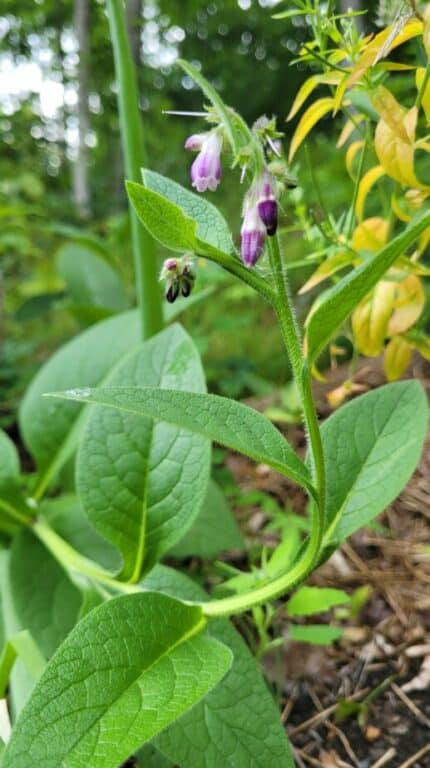
Comfrey is native to Europe but sterile strains are popular in most food forests around the world in zones 3-10.
We have Russian comfrey (bocking-14 strain). The reason a sterile strain of comfrey is popular as opposed to the reproduction-ready version is that it is described as impossible to remove.
I can’t tell you from experience if it is hard to remove because we have not tried to remove our comfrey. If we do, we will likely make more plants during the attempt to eradicate it.
I can tell you from experience, that it is incredibly easy to propagate by root, even small fragments of the root. So I do believe what ‘they‘ say about tough removal.
Nitrogen, potassium, and phosphorus are accumulated in this plant at varying degrees, and either way, it’s a nutrient-dense green manure for any compost pile or on-the-spot mulcher.
The best pollinator plants for fruit tree guilds
Usually, native flowering plants are going to be the best pollinator plants for your fruit tree guild. Including non-popular natives around your trees will help increase the diversity and strength of your ecosystem.
Pollinator plants are best on the outer edge of the tree canopy so the flowering plants can receive ample sun.
| Edible | N-Fixer | Pollin. | S.C. | Repel. | W.S. | Mulch | D.A | |
| Coneflower | Y | Y | ||||||
| Goldenrod | Y | |||||||
| Common bugloss | Y | Y | Y | Y | ||||
| Borage | Y | Y | Y | |||||
| Asters | Y | Y | ||||||
| Milkweed | Y | |||||||
| Bee balm | Y | Y | Y | Y |
Coneflower (Echinacea purpurea)

- Native to North America
- Flowers in all colors, and attracts a variety of pollinators and bird
- Edible leaves, and medicinal qualities
- Ornamental and easy to grow and save seed
Goldenrod (Solidago canadensis)
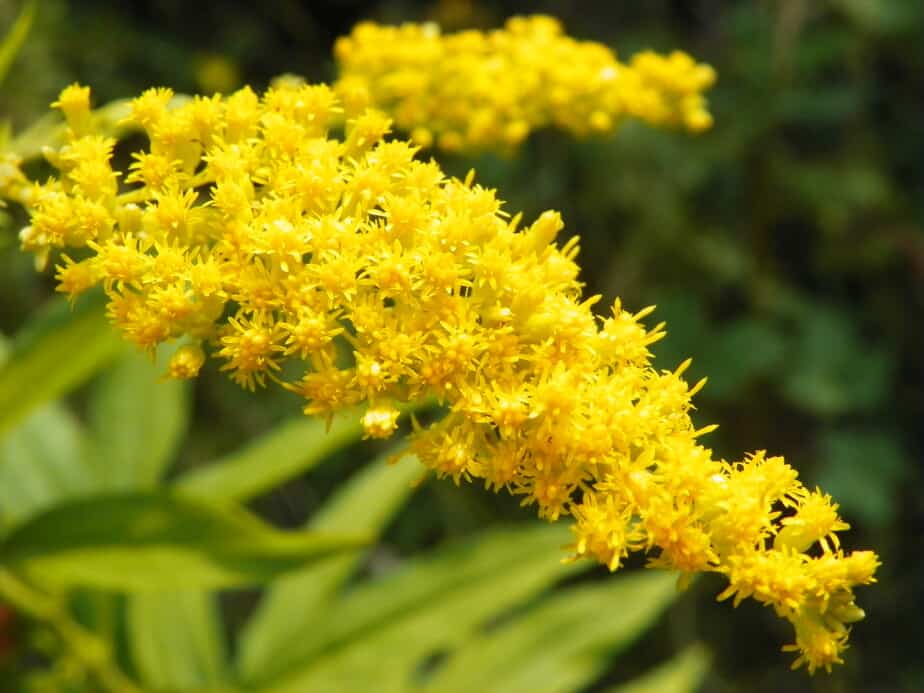
- Native to North America
- Thought to cause allergies, but the culprit is actually ragweed!
- Edible and medicinal
- Gorgeous gold in August and October
- While this plant isn’t the best partner because they take up a lot of resources, it does attract plenty of beneficial predators to keep pests in check. As a pollinator attraction; this is a great native to have on-site (if you live in the native range), even on the sidelines if not in a guild.
Common bugloss (Anchusa officinalis)
- Native to Asia
- Rich with nectar for bees and other pollinators
- Edible flowers, leaves, and shoots
- Medicinal
- Gorgeous & scented foliage
Borage (Borago officinalis)

- Native to Europe
- An annual that reseeds well and easy to save seeds
- Popularly grown in North America as it’s great for attracting pollinators
- Gorgeous flowers blue or white
- Repels deer with prickly foliage
- Edible leaves added to water freshen up a cold glass with a cucumber taste
Asters (Aster cordifolius)
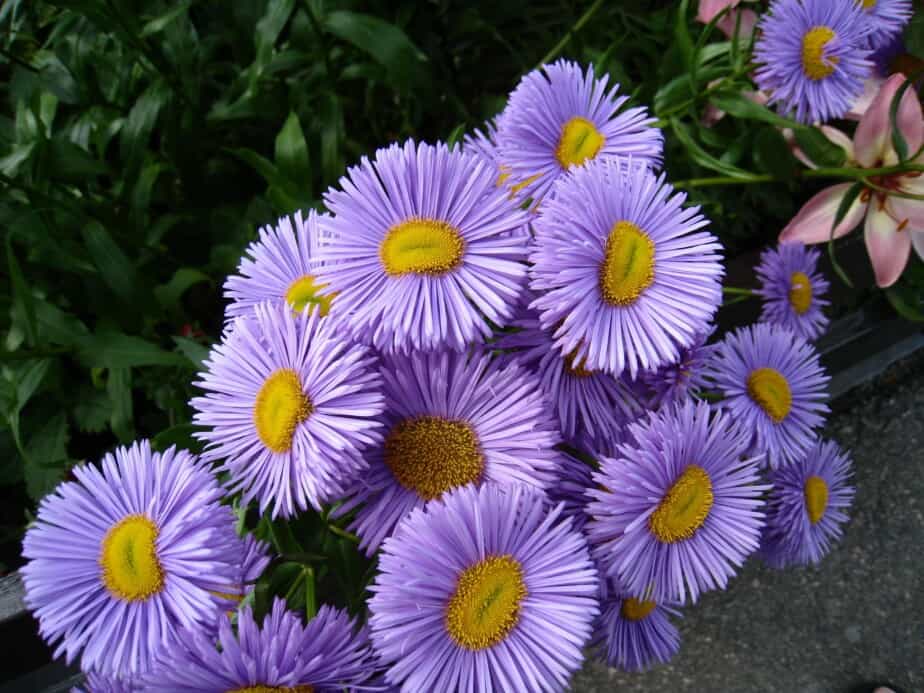
- Native to North America
- Attracts pollinators from August to October with fine flowers of blue, white, pink, and purple
- Edible for tea
- The final sign that winter is not only coming but is nearly here
Milkweed (Asclepias syriaca)
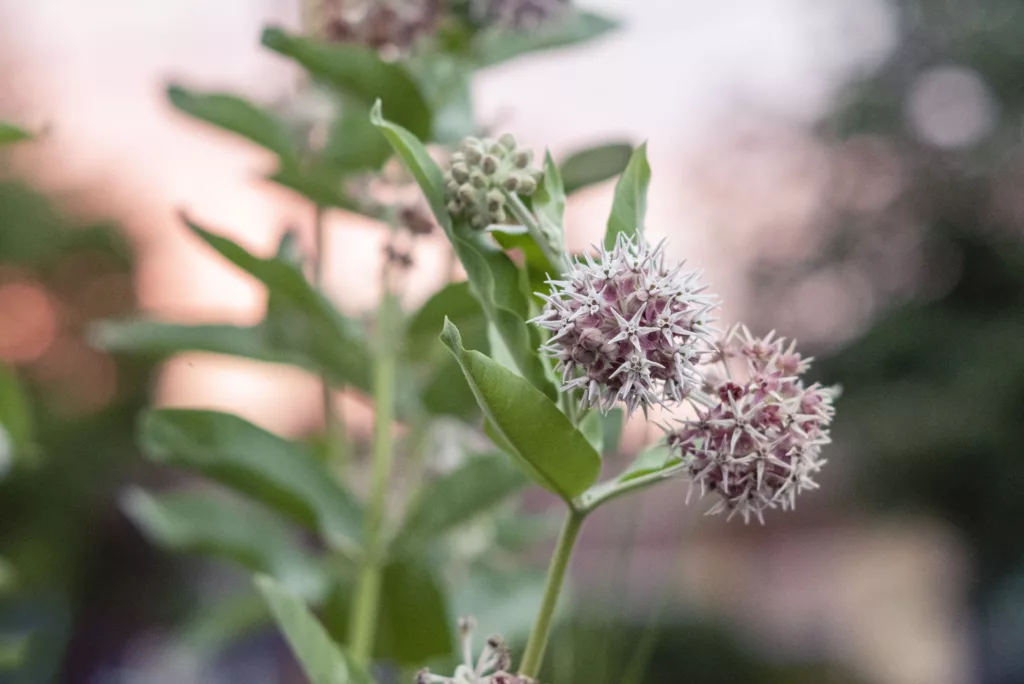
- Native to North America
- Essential for monarch butterflies, and it attracts bees and other helpful pollinators with a pleasant fragrance and plenty of nectar
- Edible flowers and seed pod
Bee Balm (Monarda fistulosa)

Every time I pick a flower or two for bee balm tea, I nearly grab a bee in the process.
Scary but true!
Bee balm is an excellent pollinator plant and therefore a beneficial companion to have around your fruit trees too.
- Native to North America
- Always surrounded by bees in July, and never touched by deer
- Fragrant edible flowers and foliage
Bee balm is also one of the best scent-confuser plants, see more below.
Related: Best Bee-Friendly Plants For Clay Soil Improvement
The best scent confuser plants for fruit tree guilds
“Scent confusers” are fragrant plants. The key to making scents confusing is to have a large variety of them. If you have one type of fragrant plant, the scents aren’t very confusing. Perhaps repelling to some critters, but less “confusion” is considered less resilient to some pests.
Usually, any fragrant plant that you notice is easy to grow, and is never harmed by pests, is likely a great “scent confuser.”
Upright, non-spreading scent-confusers are suitable companions for trees as they won’t vigorously take over the space. Mint, for example, isn’t the best companion for fruit trees as the vigorous and spreading root system take over and compete with the trees’ upper roots.
Below, I’ve included a variety of scents to consider for your food forest for the ultimate scent-confusion combination.
Scent confusers that tolerate shade can be placed closer to the tree while the sun-loving herbs can stagger toward the outer edge of the tree canopy.
| Edible | N-Fixer | Pollin. | S.C. | Repel. | W.S. | Mulch | D.A | |
| Chives | Y | Y | Y | Y | ||||
| Lavender | Y | Y | Y | Y | ||||
| Lemon balm | Y | Y | Y | |||||
| Wormwood | Y | Y | ||||||
| Sage | Y | Y |
Chives
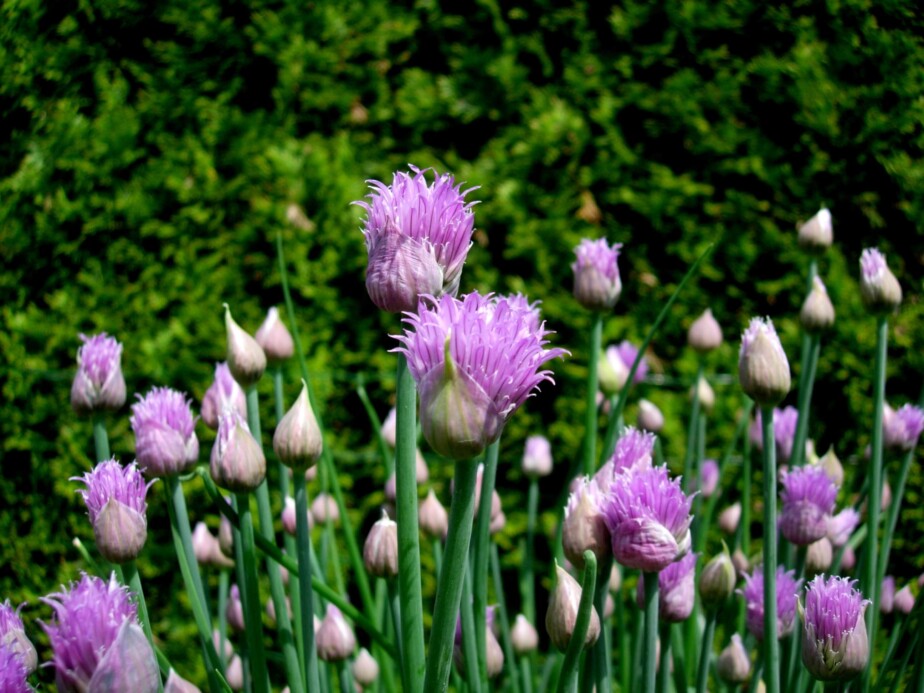
Onion and garlic chives are both delicious and offer slightly different smells.
Each with pollinator-friendly flowers they are best situated in full sun but tolerates light shade too.
Lavender
The foliage and flowers of lavender offer a very different smell from garlic or onion.
Lavender is a compact upright plant that resembles rosemary—another good scent-confuser. The growth habit makes it easy to squeeze into an empty space.
Lavender needs full sun.
Lemon balm
Lemon balm smells like it sounds but with a more fragrant punch than an actual lemon.
Full sun or light shade is a suitable position.
Wormwood
Many describe wormwood to smell similar to sage, I’d say a little more bitter, and generally different.
Plant in full sun or partial shade.
Sage
One of my favorite herbs for tea. I’ve never seen them touched by deer or other insects.
Plant in partial shade or full sun.
The best repellent plants for fruit tree guilds
Repellent plants come in all sorts of defense mechanism shapes and sizes.
Deer-repelling plants are best mixed with the pollinator plants along the outer edge of the guild to repel deer from stepping closer to the tree.
Pest (bug) repelling plants can be scattered randomly about, as usually, these would be scent-confusers!
| Edible | N-Fixer | Pollin. | S.C. | Repel. | W.S. | Mulch | D.A | |
| Daffodils | Y | Y | ||||||
| Garlic | Y | Y | Y | |||||
| Lungwort | Y | Y | ||||||
| Irises | Y | Y |
Daffodils are a “fodder” repellent as they contain compounds toxic to deer; so they stay away from these beauties altogether.
Garlic is too strong-smelling for deer and other animals. Most animals have a higher sense of smell than we do, so they tend to stay away from strong fragrances.
Lungwort is annoying to brush by and touch. Deer stay away from patches of plants, such as lungwort, or lambs ear, as they aren’t pleasant to walk through in general.
Irises are pestered by many critters, but what they do bring to the table (like many other pollinator plants) is attract predators. Predator-attracting plants are considered a repellent in the way that balance is increasingly restored by their presence.
The best ground covers to suppress weeds around fruit trees
A ground cover that suppresses weeds shouldn’t compete with the tree.
| Edible | N-Fixer | Pollin. | S.C. | Repel. | W.S. | Mulch | D.A | |
| White clover | Y | Y | Y | Y | Y | |||
| Mountain mint | Y | Y | Y | Y | Y | |||
| Moss phlox | Y | Y | Y | Y |
Clover
If you’d rather employ a living mulch as a weed suppressor, clover is an option that works for many orchards and food forests.
Any ground cover with a surface-level root system will compete with the tree’s feeder roots, but this doesn’t mean your trees won’t do well.
Many growers have thriving trees and a clover ground cover right up to the trunk of the tree.
Clover doesn’t attract tree pests such as japanese beetles as grass can, but rather beneficial pollinators.
It’s also a nitrogen fixer and edible for sauteed greens or tea from the flowers.
Mountain mint
Mountain mint suppresses weeds like regular mint, but without being invasive! Deer are also repelled from the aroma like regular mint so the benefits are all there.
The major difference is that regular mint is a low-growing ground cover. Mountain mint stands about 2-3 feet tall and is an upright herbaceous perennial.
Moss phlox
Moss phlox forms a dense mat and effectively prevents weeds from growing through. The flowers are just as dense as the foliage during bloom and attract plenty of pollinators.
The best chop-and-drop plants for fruit tree guilds
Chop and drop plants are also great weed suppressors, although they may not cover whole areas of ground, the mulch from them can. The difference between a weed suppressor and a mulcher crop is the harvestability. Chop and drop plants can withstand repeated cutbacks and continue to grow as if nothing happened.
The best chop-and-drop plants not only combine biomass and harvestability, but also nutrient density.
| Edible | N-Fixer | Pollin. | S.C. | Repel. | W.S. | Mulch | D.A | |
| Rhubarb | Y | Y | Y | Y | Y | |||
| Comfrey | Y | Y | Y | Y | ||||
| Yarrow | Y | Y | Y | Y | Y | |||
| Swiss Chard | Y | Y |
Rhubarb
Rhubarb is a fast-growing plant with large leaves. The leaves are great for mulching and returning biomass to the soil.
Since the leaves are poisonous it’s a perfect plant that ensures you’ll give half to the soil and only take the edible stalk.
Soil building is necessary for the longevity of your fruit trees!
Comfrey
What makes this plant so popular is the amount of biomass it can produce. It’ll grow and grow without stunting even after chopping it back 3-4 times in a single season.
Swiss chard
Swiss chard is an edible annual often grown for use as a vegetable. Most often, people don’t favor swiss chard above all else so it easily takes a back seat on the priorities list.
Anyone who’s grown swiss chard knows how easy it is. Which makes it an attractive mulcher.
The leaves are big and colorful, and it grows without a fuss. Even if it gets attacked over a portion of the season, it doesn’t last healthy new leaves continue to grow.
Simply take the large outer leaves and drop them on the ground where mulch is needed. New ones will grow for next week.
The best dynamic accumulators to plant with fruit trees
Dynamic accumulators are plants that compose 200% more than the average nutrients. This could mean 1-3 nutrients in the plant are significantly high compared to the average of all plants.
| Edible | N-Fixer | Pollin. | S.C. | Repel. | W.S. | Mulch | D.A | |
| Yarrow | Y | Y | Y | Y | ||||
| Comfrey | Y | Y | Y | Y | ||||
| Amaranth | Y | Y | Y | Y | ||||
| Borage | Y | Y | Y | Y | ||||
| Nettle | Y | Y | Y | Y | Y | |||
| Lambsquarters | Y | Y |
24 Best Edible Ground Covers for Shade
Recent Posts
There’s no shortage of full-sun ground covers for zone 4 climates! Each plant in this list can withstand the frigid temperatures and also enjoy the hot sun in summer. Full sun means that a plant...
There's no shortage of full sun ground covers, not even in zone 3! Zone 3 climates offer hot but short-lived summers and very cold winters. So each plant in this list can withstand the frigid...
